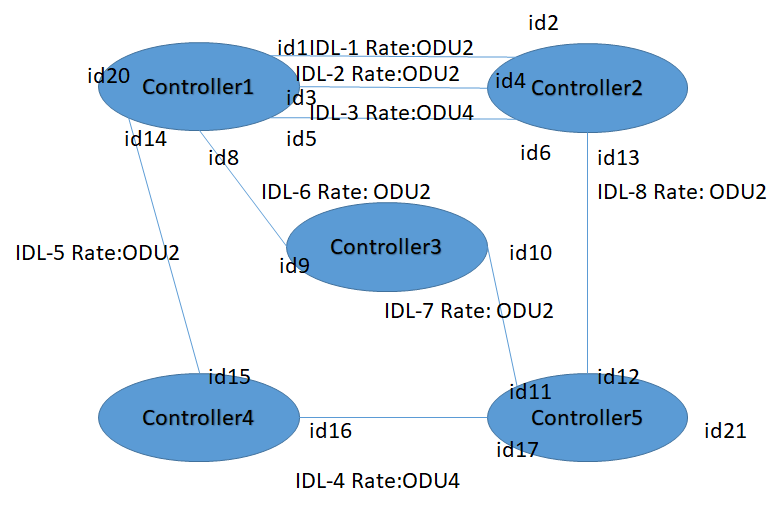...
- Identify if the A and Z are from the same domain controller, if yes, linkName is set to null.
- If not from the same domain, retrieve all the inter domain links across both the controllers from AAI.
- The links will have information such as admin-state and rate. (Note: For now we are considering only these two fields to select the appropriate inter-domain-link).
- Based on the bandwidth required and available bandwidth and the status of the links (of the end points, NNIs), the appropriate link is chosen.
- The link name along with the names of NNI 1 and NN2 are sent to SDNC and SDNC/DG send the details request for service-creation to the domain controller(s).
Example Inter Domain Paths
Non Multiplexing Between the Domains
...
Minizinc Template
Here is the Minizinc Module used in IDL Path Optimizer.
| Code Block | ||||||
|---|---|---|---|---|---|---|
| ||||||
% Number of nodes
int: N;
% Start node
1..N: Start;
% End node
1..N: End;
% Number of edges (directed arcs)
int: M;
% The actual edges
set of int: Edges = 1..M;
% Edge lengths
array[Edges] of int: L;
% Edge start node
array[Edges] of 1..N: Edge_Start;
array[Edges] of 1..N: Edge_End;
% Variable indicating if edge is used
array[Edges] of var 0..1: x;
constraint
forall( i in 1..N ) (
if i = Start then
% outgoing flow
sum(e in Edges where Edge_Start[e] = i)(x[e]) -
% incoming flow
sum(e in Edges where Edge_End[e] = i)(x[e])
= 1
elseif i = End then
sum(e in Edges where Edge_Start[e] = i)(x[e]) -
sum(e in Edges where Edge_End[e] = i)(x[e])
= -1
else
sum(e in Edges where Edge_Start[e] = i)(x[e]) -
sum(e in Edges where Edge_End[e] = i)(x[e])
= 0
endif
);
solve minimize sum(e in Edges)( L[e] * x[e] );
output ["Length: ", show(sum(e in Edges)(L[e] * x[e])), "\n"] ++
["Start : ", show(Start), "\n"] ++
["End : ", show(End), "\n\n"] ++
["Edges in shortest path:\n"] ++
[ if fix(x[e]) = 1
then show(Edge_Start[e]) ++ " -> " ++ show(Edge_End[e]) ++ "\n"
else ""
endif | e in Edges
];
|
Example Inter Domain Paths
Non Multiplexing Between the Domains
- Route optimizer receives the service route request from SDNC with the source and destination interface ids.
- The controllers of both the points are found using the AAI queries.
- Then optimizer queries AAI to fetch all the possible Controllers in the inventory to send it to minizinc. It fetches all the inter-domain links from the inventory and filters it based on the "rate" mentioned in the request and the operational status "up".
- Since minizinc expects the data in a certain way, optimizer wil encode all the data retrieved using the sckit module in python and send it to minizinc.
- The pymzn module is used to interface python with the minizinc language.
- Once minizinc chooses the optimized path, the optimizer will again decode the data and find the chosen links from the source to the destination.
- The optimizer then would fetch the interface details from the link and form a proper service route list that would be sent back to SDNC along with the list of logical links.
- SDNC in turn will fetch the end points from the service routes list object from the response and create as many domain services as present in the service route list.
- The logical links in the response will be used to form the relationship with the access service which will be done by SDNC.
- For the above example if a route has to be found between the "id20" of Controller1 "id21" of Controller5 following request will be sent to OOF by SDNC defined above.
- After running the algorithm OOF wil return the following response defined above.
Multiplexing Between the Domains
...
